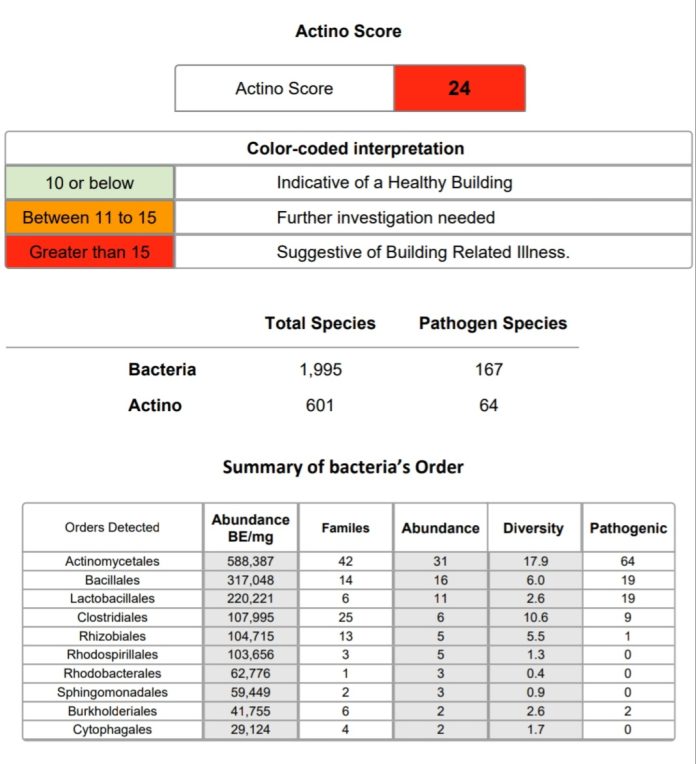What is an Actino Score Test Report?
The Actino Score Test Report is a specialized environmental assessment tool used to evaluate the presence and concentration of Actinobacteria in indoor environments. This test is particularly important for identifying potential health risks associated with water-damaged buildings and mold-related illnesses.
Key Components of the Report
The Actino Score Test Report typically includes several important metrics:
- Actino Score: A numerical value that indicates the overall level of Actinobacteria present in the sample. The score ranges are interpreted as follows:
- 9 or below: Indicative of a Healthy Building
- Between 10 to 15: Further investigation needed
- Greater than 15: Suggestive of Building-Related Illness
- Dominance Index (DI): This index compares the presence of human habitat (HH) species to soil habitat (SH) species. A DI greater than 2.0 indicates more HH species than SH species.
- Prevalence Index (PI): This measures the number of HH organisms compared to SH organisms. A PI greater than 2.0 suggests a higher number of HH organisms.
- Actino Abundance: The percentage of Actinobacteria present in the total bacterial population of the sample.
What Does the Actino Score Test Determine?
The Actino Score Test Report helps determine:
- The presence and concentration of potentially harmful Actinobacteria in indoor environments.
- The likelihood of Building-Related Illness based on the Actino Score.
- The balance between human habitat and soil habitat bacterial species.
- Potential water damage or moisture issues in buildings.
Importance of the Test
The Actino Score Test plays a crucial role in maintaining healthy indoor environments and protecting human health. Here’s an expanded look at its importance:
- Early Detection of Health Risks: By identifying elevated levels of Actinobacteria, the test can alert occupants to potential health hazards before they manifest as serious illnesses. This early warning system is invaluable for preventing long-term health issues associated with poor indoor air quality.
- Diagnostic Tool for Healthcare Professionals: Medical practitioners can use the Actino Score Test results to aid in diagnosing mold-related illnesses. The test provides objective data that can corroborate patient symptoms and guide treatment plans.
- Guiding Remediation Efforts: For building owners and managers, the test results offer clear indicators of where remediation efforts should be focused. This targeted approach can save time and resources by pinpointing problem areas that require immediate attention.
- Assessing Building Health: The Actino Score serves as a comprehensive measure of a building’s microbial health. It helps in evaluating the effectiveness of HVAC systems, moisture control measures, and overall building maintenance practices.
- Legal and Insurance Purposes: In cases of disputes or insurance claims related to building health, the Actino Score Test Report provides scientific evidence that can be crucial in resolving issues or supporting claims.
- Preventive Maintenance: Regular testing can help in establishing a baseline for normal Actinobacteria levels in a building. This allows for the early detection of any changes that might indicate developing problems, enabling preventive measures to be taken before issues escalate.
- Enhancing Indoor Air Quality Programs: The test results can be integrated into broader indoor air quality management programs, helping to create more comprehensive and effective strategies for maintaining healthy indoor environments.
- Occupant Peace of Mind: For building occupants, knowing that their environment is regularly tested and maintained can provide peace of mind and contribute to overall well-being and productivity.
By providing a comprehensive analysis of Actinobacteria presence, the Actino Score Test Report serves as a valuable tool for healthcare professionals, building inspectors, property managers, and individuals concerned about indoor air quality and its impact on health. Its multifaceted importance underscores the need for regular testing and proactive management of indoor environments to ensure the health and safety of occupants.


